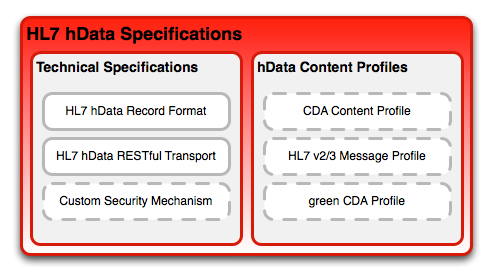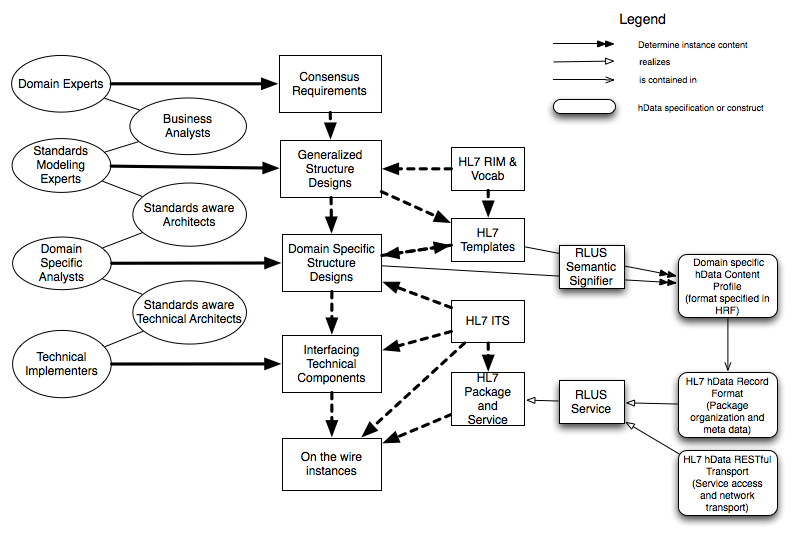HData
Return to Main Innovations Page
Overview
hData is a set of specifications that have been developed with ease-of-implementation in mind. hData was first presented to a wider audience within HL7 as the September 2009 meeting in Atlanta, GA. Since then, hData has first been evalauted as a HL7 research project within the ITS working group. The research project culminated in a "For Comment" ballot in January 2011. After a carefull analysis, HL7 decided to standardize hData under the leadership of the SOA working group with ITS and MnM as interested parties.
Weekly Project Conference Call
Based on the discussions in Orlando 2011, we are having a weekly conference call on Tuesdays, 5pm - 6pm EDT/9pm - 10pm GMT.
Call is scheduled for 1.0 hour
Phone Number: +1 770-657-9270 Participant Passcode: 071582
Online collaboration information (telephone conference unchanged)
1. Go to: http://audioconference.mitre.org
2. Enter 323865 into the empty field and click Attend Meeting. Use you name for the username field. Password is 12345678
3. If MeetingPlace Collaboration Window does not automatically open, press connect.
Meeting ID: 323865
Meeting Password: 12345678
Agendas and Meeting Notes
hData/Agendas and Meeting Notes/2011-06-14
Specifications
hData currently consists of two specifications which are both in draft:
- The hData Record Format (HRF) specifies how multiple documents (XML and non-XML media types) containing medical data can be hierarchically organized. It allows metadata management per individual document, signature over files, linking of related documents, and defines the items needed to define a complete hData Content Profile (HCP). The current project scope statement is here.
- The hData RESTful Transport specifies how a record adhering to the HRF specification can be access through a RESTful approach using HTTP as the transport protocol.
hData requires strong separation of the technical representation and transport technology on the one side, and the clinical content of an electronic health record on the other side. To this end, hData has the concept of hData Content Profiles (HCP), which define what kind of content is represented and transport through hData. It should be note that conceptually CDA and hData are similar in their approach to representing data points in a hierarchical way.
It should be noted that the two specification are not an ITS in the traditional sense, since they do not determine how a logical model is implemented and rendered on the wire. Instead, the HRF organizes existing “exchangeable goods” such as HL7 artifacts, other XML documents, and other media types (including images and other binary data) in a hierarchical structure and provides data pedigree meta data.
hData records may adhere to the content required by an hData Content Profile (HCP): a content profile prescribes the required and optional content a record must provide, and allocates the place for the Section Documents within the hierarchical structure. Note that a single hData record can be compliant with multiple HCPs.
HCP Example
The following record would be compliant with all three HCPs: / -
+ /ccd
+ /imaging/x-rays
- /simple -
+ /allergies
- /meds
Other combinations are possible as well. |
Relationship with HL7 Framework
The illustration below was created by the ArB and annotated by hData to illustrate how hData fits into the HL7 SAIF:
Supporting Documentation
Structured Document Template Design Pilot
hData is part of the Structured Document Template Design Pilot, progress can be tracked on the HData Template Sub Project page. Within this pilot it is demonstrated that hData can be made conceptually equivalent to a CDA based approach: the content of an CDA document and an hData record following the rules of the HRF specification are isomorphic, as long as an hData Content Profile is used that supports all features used in the CDA instance.
Example Schemas for Simplified C32/C83 content
Project hData initially produced a set of simplified schemas as wireformat for content (see here for more information). These schemas were derived from the content of the HITSP C83 profile of the HL7 CCD. It was not created with a rigorously defined algorithm (like greenCDA), since it was only intended to illustrate the potential benefit of simplified wireformats for a number of non-traditional applications, such as low-powered devices, rich internet applications, and other agile projects.
The current hData specification do not require the simplified schemas. Instead, hData offers the HCP methods to define content profiles for domain specific use. The content profiles will use standard HL7 v3 artifacts, but may also use simplified wireformats once they become available (e.g. through greenCDA or neutral mapping).
Presentation Material
This presentation was used to illustrate the general security concept for hData.
Overview Videos
The MITRE Corporation has created a set of overview videos here.
Links
Project hData was started by MITRE and is currently hosted on http://projecthdata.org/

